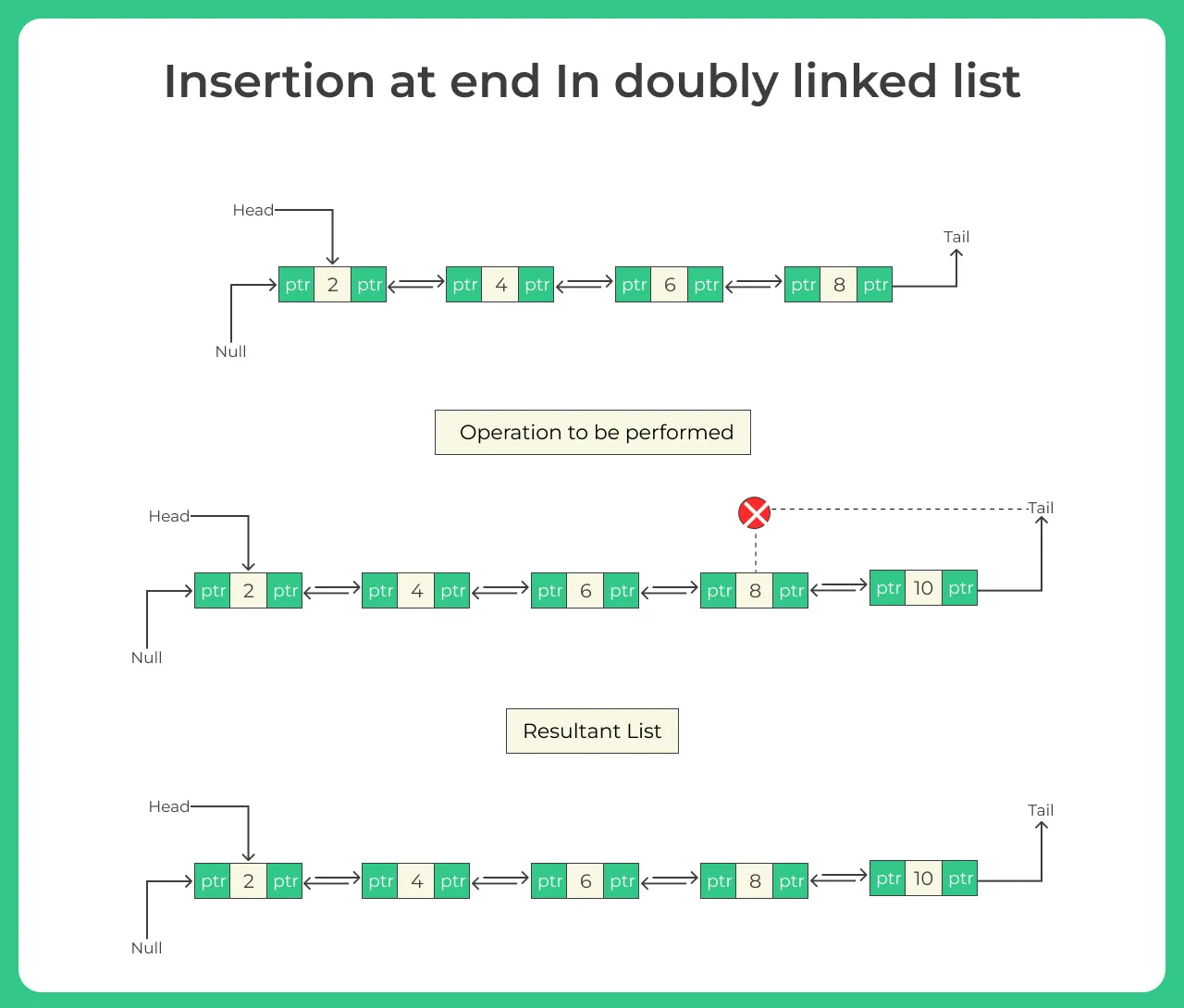0
Notifications Mark All Read
- Login
- Get Prime
JAVA program for Insertion in the End of a Doubly Linked List
JAVA Program for Insertion in the End of a Doubly Linked Last
Over here in this program we will create a linked list and add a node at the end of doubly linked list. To insert a new node at the end of a linked list we have to check that the list is empty or not. If the list is empty both head and tail points towards the newly added node. If it is not empty, in such case add a new node at the end and make sure that tail points towards the newly added node.

Steps to be followed while Inserting a Node at the End of a Doubly Linked List
- Check for the presence of Node in the List, if there exists some Nodes, Continue.
- Now, to insert a node in the end of the Doubly Linked List, we’ll have to store and redirect various links of the Linked List.
- First of all the next pointer of the previously last Node will store the address of the New Node that is being Inserted in the Linked List.
- Now Since the New Node is going to be the last Node of the Linked List. So, the Next Pointer of the New Node will point to Tail.
- Then the Previous Pointer of the New Node will now point to the Previously Last Node of the Linked List.
Example:
If we have a list (10 –> 20 –> 30 –> 40) and we have to add a new node which is 50. So after adding new node. Updated Linked list will be (10 –> 20 –> 30 –>40 –> 50) . We will be learning more about the whole process in the explanation below.

Algorithm to be used for the Insertion of a Node at the End of a Doubly Linked List
- appendAtEnd (data)
- if(HEAD == NULL)
- HEAD = TAIL = newNode
- HEAD.prev = NULL
- TAIL.next = NULL
- Else
- TAIL.next = newNode
- newNode.prev = TAIL
- TAIL = newNode
- TAIL.next = NULL
Java Program for Insertion in the end of a Doubly Linked List
import java.lang.*;
class DoublyLinkedList
{
Node head;
// not using parameterized constructor would by default
// force head instance to become null
// Node head = null; // can also do this, but not required
// Node Class
class Node
{
int data;
Node next, prev;
Node (int x) // parameterized constructor
{
data = x;
next = null;
prev = null;
}
}
public void insertEnd (int data)
{
// Creating newNode memory & assigning data value
Node freshNode = new Node (data);
// assign data
// since this will be the last node its next will be NULL
freshNode.next = null;
//if we are entering the first node
if (head == null)
{
head = freshNode;
freshNode.prev = null;
return;
}
Node last = head;
// traverse to the current last node
while (last.next != null)
last = last.next;
// assign current last node's next to this new node
// assign new node's previous to this last node
last.next = freshNode;
freshNode.prev = last;
// new_node becomes the last node now
}
public void printList ()
{
Node node = head;
Node end = null;
//as linked list will end when Node reaches Null
System.out.print ("\nIn forward: ");
while (node != null)
{
System.out.print (node.data + " ");
end = node;
node = node.next;
}
System.out.print ("\nIn backward: ");
while (end != null)
{
System.out.print (end.data + " ");
end = end.prev;
}
System.out.println ();
}
}
class Main
{
public static void main (String args[])
{
DoublyLinkedList doublylist = new DoublyLinkedList ();
doublylist.insertEnd (3);
doublylist.insertEnd (2);
doublylist.insertEnd (1);
doublylist.insertEnd (4);
doublylist.insertEnd (5);
doublylist.printList ();
}
}
Output
In forward: 3 2 1 5 4 In backward: 4 5 1 2 3
import java.lang.*;
// Node Class
class Node
{
int data;
Node next, prev;
Node (int x) // parameterized constructor
{
data = x;
next = null;
prev = null;
}
}
class Main
{
static Node insertEnd (Node head, int data)
{
// Creating newNode memory & assigning data value
Node newNode = new Node (data);
// assign data
// since this will be the last node its next will be NULL
newNode.next = null;
//if we are entering the first node
if (head == null)
{
head = newNode;
newNode.prev = null;
return head;
}
Node last = head;
// traverse to the current last node
while (last.next != null)
last = last.next;
// assign current last node's next to this new node
// assign new node's previous to this last node
last.next = newNode;
newNode.prev = last;
// new_node becomes the last node now
return head;
}
static void printList (Node temp)
{
Node end = null;
//as linked list will end when Node reaches Null
System.out.print ("\nIn forward: ");
while (temp != null)
{
System.out.print (temp.data + " ");
end = temp;
temp = temp.next;
}
System.out.print ("\nIn backward: ");
while (end != null)
{
System.out.print (end.data + " ");
end = end.prev;
}
System.out.println ();
}
// required for insertAfterPosition() method
static int getLength (Node node)
{
int size = 0;
// traverse to the last node each time incrementing the size
while (node != null)
{
node = node.next;
size++;
}
return size;
}
public static void main (String args[])
{
Node head = null;
head = insertEnd (head, 3);
head = insertEnd (head, 2);
head = insertEnd (head, 1);
head = insertEnd (head, 5);
head = insertEnd (head, 4);
printList (head);
}
}
Output
In forward: 3 2 1 5 4 In backward: 4 5 1 2 3
Prime Course Trailer
Related Banners
Get PrepInsta Prime & get Access to all 200+ courses offered by PrepInsta in One Subscription
Get over 200+ course One Subscription
Courses like AI/ML, Cloud Computing, Ethical Hacking, C, C++, Java, Python, DSA (All Languages), Competitive Coding (All Languages), TCS, Infosys, Wipro, Amazon, DBMS, SQL and others
Doubly Linked List
- Introduction to Doubly Linked list in Data Structure
Click Here - Doubly Linked List in –
- Insertion in doubly linked list –
- Insertion at beginning in doubly linked list –
- Insertion at end in doubly linked list –
- Insertion at nth node in doubly linked list –
- Deletion in doubly linked list –
- Deletion from beginning in doubly linked list :
- Deletion from nth in doubly linked list :
- Deletion from end in doubly linked list :
- Insertion and Deletion in a doubly linked list :
- Insertion in the middle in a doubly linked list :
Doubly Linked List
- Introduction to Doubly Linked list in Data Structure
- Doubly Linked List in – C | C++ | Java
- Insertion in doubly linked list – C | C++ | Java
- Deletion in doubly linked list – C | C++ | Java
- Insertion and Deletion in doubly linked list – C | C++ | Java
- Insertion in the middle in a doubly linked list – C | C++ | Java

 0
0



Login/Signup to comment